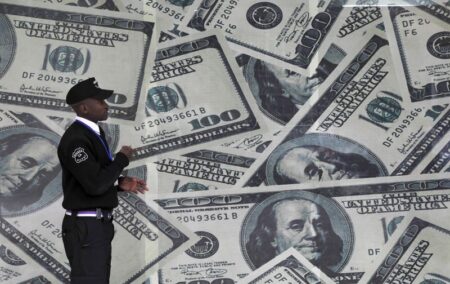By Tom Westbrook
SINGAPORE (Reuters) -The dollar tracked toward monthly gains on Thursday ahead of highly-anticipated inflation data that could ruffle the interest rate outlook, while the sliding yen found a footing after a policymaker hinted at the need to exit ultra-easy policies.
was on the charge, topping $63,000 early in the European morning for a gain of nearly 50% in February. The monthly rise is the largest since December 2020, and a record high above $69,000 is within sight. It was last at $63,051.
The yen and fellow safe-haven Swiss franc are the worst performing G10 currencies against the dollar this month as investors have sought out riskier assets and as bets on U.S. interest rate cuts have been dialled back – lifting the dollar.
The yen last traded at 149.87 to the dollar, down about 2% on the month. It was almost 0.6% higher on the day after Bank of Japan board member Hajime Takata said he felt there were finally prospects for achieving the bank’s 2% inflation target, paving the way to leave behind negative rates and yield caps.
The yen is down more than 2% on the euro this month and made nine-year lows on the Australian and New Zealand dollars as investors pick up income by borrowing yen at rates near zero and selling it against currencies where interest rates are higher.
“Takata’s remarks should add to conviction that an earlier than expected hike at March meeting should not be ruled out,” said Christopher Wong, currency strategist at OCBC.
“With JPY shorts at record high, unwinding of shorts should see JPY bears run for cover.”
The euro was steady at $1.0835 and largely flat for the month, as was sterling at $1.2665. The Australian and New Zealand dollars have lost ground in February as expectations firmed that rate hikes have finished down under.
The New Zealand dollar in particular nursed losses at $0.6105, having dropped 1.2% on the dollar a day ago when the central bank held rates and surprised markets with a downward tweak to its rates forecast. The Australian dollar ticked 0.3% higher to $0.6516 on Thursday for a monthly drop of 0.8%.
The Federal Reserve’s favoured measure of inflation – the core personal consumption expenditures (PCE) price index – is due later on Thursday and forecasts are for a rise of 0.4%.
It was not long ago investors were hoping for just a 0.2% increase but high readings on consumer and producer prices suggest the risk is for a result as high as 0.5%.
“A stronger than expected PCE deflator can cause markets to reduce pricing for a May rate cut even further, supporting U.S. dollar,” said Commonwealth Bank of Australia (OTC:) currency strategist Kristina Clifton.
Markets price about a 20% chance of a Fed easing in May, and have pushed out the likely timing of a cut to June. Futures imply a little more than three 25 basis point cuts this year, compared to five at the start of the month.
The was little changed at 103.86.
Read the full article here










